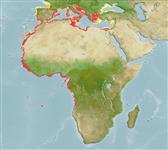Common names from other countries
Environment: milieu / climate zone / depth range / distribution range
Ecologia
marinhas; estuarina bentopelágico; oceanódromo (Ref. 3688); intervalo de profundidade 1 - 200 m (Ref. 4781), usually 30 - 50 m (Ref. 2683). Subtropical; 45°N - 17°S, 19°W - 36°E
Eastern Atlantic: Portugal and Strait of Gibraltar to Angola, including the Mediterranean.
Length at first maturity / Tamanho / Peso / Idade
Maturity: Lm 18.7, range 17 - 23 cm
Max length : 90.0 cm SL macho/indeterminado; (Ref. 4781); common length : 50.0 cm SL macho/indeterminado; (Ref. 4781); peso máx. Publicado: 11.6 kg (Ref. 40637)
Generally found in hard bottoms (rocks and rubble), the older individuals in the deeper part of the range, the young in inshore areas. Feed mainly on bivalves and also on crustaceans and fish. Sexual maturity at 2 years old. Spawning migration occurs parallel to the coast with intermittent spawning between spring and autumn over soft bottoms in shallow waters (Ref. 3688).
Life cycle and mating behavior
Maturities | Reprodução | Spawnings | Egg(s) | Fecundities | Larvas
A different diagnosis of sexual pattern may arise for this species brought about by geographical variations (Ref. 103751). Also Ref. 41163.
Bauchot, M.-L. and J.-C. Hureau, 1990. Sparidae. p. 790-812. In J.C. Quero, J.C. Hureau, C. Karrer, A. Post and L. Saldanha (eds.) Check-list of the fishes of the eastern tropical Atlantic (CLOFETA). JNICT, Lisbon; SEI, Paris; and UNESCO, Paris. Vol. 2. (Ref. 3688)
Categoria na Lista Vermelha da IUCN (Ref. 130435)
CITES (Ref. 128078)
Not Evaluated
Ameaça para o homem
Harmless
Utilização humana
Pescarias: espécies comerciais; peixe desportivo: sim
Ferramentas
Relatórios especiais
Descarregue XML
Fontes da internet
Estimates based on models
Preferred temperature (Ref.
115969): 13.3 - 25.2, mean 17.5 (based on 97 cells).
Phylogenetic diversity index (Ref.
82804): PD
50 = 0.5156 [Uniqueness, from 0.5 = low to 2.0 = high].
Bayesian length-weight: a=0.01995 (0.01695 - 0.02348), b=2.95 (2.91 - 2.99), in cm Total Length, based on LWR estimates for this species (Ref.
93245).
Nível Trófico (Ref.
69278): 3.7 ±0.54 se; based on food items.
Resiliência (Ref.
120179): Médio, tempo mínimo de duplicação da população 1,4 - 4,4 anos (K=0.28; tmax=10; tm=2).
Fishing Vulnerability (Ref.
59153): Moderate to high vulnerability (46 of 100).
Climate Vulnerability (Ref.
125649): Moderate to high vulnerability (54 of 100).
